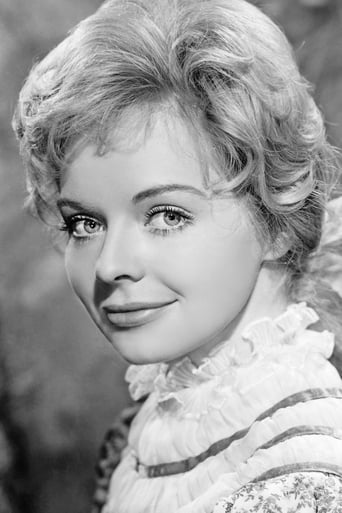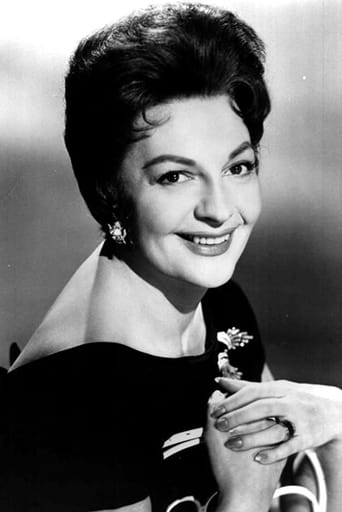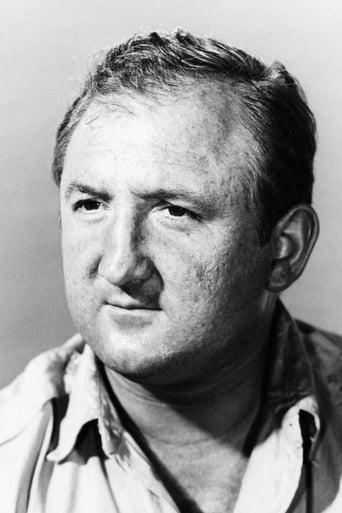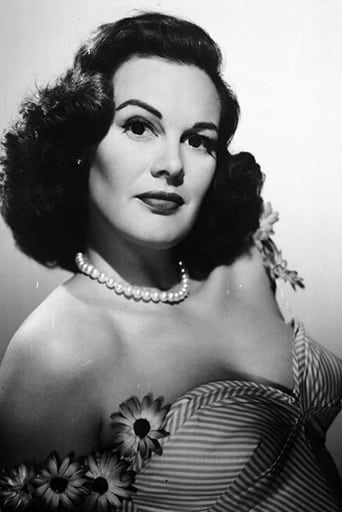Actuakers
One of my all time favorites.
GurlyIamBeach
Instant Favorite.
Lidia Draper
Great example of an old-fashioned, pure-at-heart escapist event movie that doesn't pretend to be anything that it's not and has boat loads of fun being its own ludicrous self.
meathookcinema
One of the earliest British gay-themed films ever made, this tells the tale of June 'George' Buckridge, the soon to be eclipsed star on the TV soap opera Applehurst. We see her relationship with the Baby Doll-like Childie and also the interventions of television executive Mrs Crofts. But does Crofts have her own agenda?This lesbian drama has the amazing tagline 'The story of three consenting adults in the privacy of their own home' which obviously mimics the mantra of liberals and homophobes alike regarding 'the gays'. It's also a reference to the wording of The Sexual Offences Act of 1967 decriminalising homosexuality. There's something aesthetically pleasing about Beryl Reid in all of the films and TV programmes I've seen her in. This film is no exception. She plays George and she dominates proceedings whenever she is on screen. Her character is irreverent, rambunctious and a sheer delight. She's 'punk' years before the punk movement actually erupted. Also, notice how she plays her rebellious character to perfection and got under the skin of George. This is very evident in her body language. No unconscious crossing of the legs or keeping them together when she sits down. She can manspread with the best of them. This is a headstrong woman who lives life on her own terms rather than conforming to societal norms regarding how a 'lady' should act.Part of the film takes place in the real life lesbian bar The Gateways Club which was then in Chelsea, just off The Kings Road. The film used the real patrons as extras and it feels so natural it's as if the crew just went in and filmed without warning. The wide range of cast extras show that the uneducated myth about lesbians being either 'butch' or 'femme' is a fallacy and the locale provides a fascinating peek inside not just 1960's Gay London but specifically Lesbian London. George and Childie are also dressed as Laurel and Hardy in this scene which makes it even more joyous, surreal and brilliant.A primary theme of the film is the power play within the character's relationships. This is nicely shown in the 'contrition game' scene in which rather than being degraded by George's task, Childie makes herself enjoy it thus taking away the power from George and being in control herself. The film depicts it's characters like human beings with all of their foibles rather than as freaks in a sideshow to be leered at and grimaced at by 'them there normal folks'. The film prompts a new discussion on our perceptions of gay people in a Britain in which homosexuality had just been decriminalised (this was carried out in 1967- the year before this film was released). The tagline for the film also references the wording used in The Sexual Offences Act.The Killing of Sister George was unsurprisingly very contentious with the unenlightened British Board of Film Classification when it was due to be released. The main bone of contention was with the scene between Childie and Mrs Crofts- Crofts kisses and caresses Childie. There is nothing gratuitous about this scene and it is dealt with respectfully and mostly takes place off-screen. From the BBFC Case Study regarding the film-''(But) the BBFC was adamant that the scene be removed in its entirety. Trevelyan stated that the BBFC was "not prepared as yet to accept lesbian sex to this point.''It's unbelieveable today that the BBFC saw to not include this scene not because it may corrupt or adversely influence but because they thought the Great British public would have it's collective minds blown by such a scene.The BBFC Case Study on the film notes-''The BBFC classified The Killing of Sister George as 'X' in February 1969, with the encounter between Mrs Crofts and Childie deleted. Nevertheless, a number of local authorities across the UK banned the film even in this version. The Greater London Council allowed the film to be shown within its authority area with minor edits. The increase in the age bar for 'X' films from 16 to 18 in 1970 saw some local authorities relent on their previous decision and allow the film to be shown under this higher age restriction.''Today the film is thankfully uncut. This movie is an amazing time capsule, a perceptive and all too revealing glimpse into human relationships and a groundbreaking slice of LGBT history- a history that generally erases lesbians altogether. This film noisily and joyously bucks this trend. And audiences should be truly thankful for that.
Tim Kidner
Seeing Beryl Reid mouth silently a four-letter swear word when such things didn't happen in films and drunkenly canoodling with two young nuns in the back of a London cab is both quite outstanding and rather lovable.Miss Reid, who I only got to see in my childhood as a twee, granny-like innocent (the sort that she plays for real in a TV serial as Sister George, a homely district nurse), I found The Killing Of... both delicious and ever astounding in its frankness and of her rather warped relationship with the much younger Susannah York.Warped, not because of the age difference, nor of their same-sex partnership, but because June Buckridge (Reid) has a cruel streak that is borne out by her playing sadistic mind games with Alice "Childie" (York).Sister George, in the best tradition of TV soaps, is being killed off, to make way for an Australian replacement. Hence June's venomous outpourings and increasingly erratic behaviour.Equally interesting is the London of the late '60s, both in its landmarks but also its people and fashions, whether that's in how they live and/or how they dress and present themselves.Though real soaps cover such material freely and openly these days, 42 years ago, it must have been a very different kettle of fish. Lesbianism back in those days was not only considered immoral but also a mental aberration and had to be so hidden, in an attempt to prove to those 'righteous' souls that it did not exist. Therefore, it must have been a very brave undertaking as a film, though it originated as a play, written by Frank Marcus.Having now seen it again, I consider Robert Aldrich's ground-breaking film to be a bit of a classic and one, which, no doubt I'll want to see again in a few years time. It really is a piece of British cinematic history.
Scott Amundsen
The same year that Mart Crowley's landmark play about Gay men in New York, THE BOYS IN THE BAND, opened off-Broadway, Robert Aldrich, one of Hollywood's brightest and most versatile voices, gave us the distaff version with his adaptation of Frank Marcus's play THE KILLING OF SISTER GEORGE. Two years later, William Friedkin would bring Crowley's work to the screen, with much better results than Aldrich achieves here, but I think it is only fair to point out that, flaws and all, Marcus and Aldrich got there first.And they brought a cast of heavy-hitters with them: Beryl Reid, a force of nature as June Buckridge ("Sister George," a nurse on a popular soap opera), Susannah York as her somewhat infantile lover "Childie," and the third point in the triangle, a serpentine BBC executive by the name of Mercy Croft, played to a fare-thee-well by Coral Browne, who has a dual agenda: telling June that she's been sacked and stealing Childie from her into the bargain.The acting by all three of these women is, in a word, sensational. Reid in particular dominates the proceedings: June Buckridge is an unpleasant, loud, obnoxious woman who is abusive to her lover. York, however, it must be said, is no slouch in the role of the submissive Childie; in fact, there is one scene with a cigar butt where Childie turns the tables on "George" with devilish glee. And Browne as Mrs Croft is a perfect foil for the both of them: a serpent in a Chanel suit; oozing style from every pore while scheming to get her way.The only problem is that the basic situation really isn't enough to hang a two-hour-and-eighteen-minute movie on. With THE BOYS IN THE BAND, setting the proceedings at a birthday party allowed the drama to unfold almost in real time, with room for a cast of nine actors crammed into a fancy Village apartment; the claustrophobic nature of the set actually works in the film's favor.Unfortunately, GEORGE is a bare-bones story of an aging actress about to lose a job that she has grown to take for granted, much as she takes for granted her lover, a woman who retreats into her dolls when under stress and whom George abuses mercilessly. Childie, as I mentioned, sometimes gets her own back, and once or twice we see some real affection between the two women, but halfway through this thing I found them both quite unbearable and I had a hard time swallowing the notion that either of them would stand for the other's nonsense for so many years. The addition of Mrs Croft to the proceedings does add a little something extra, but though Browne works hard, the part is underwritten and we really don't understand what motivates her. Is she really attracted to Childie, or is she just a bitch out to get George, and taking her lover just an added bit of venom? In the end we are forced to draw our own conclusions. And June, as difficult as she has been, is most certainly the one left with the short end of the stick as the curtain falls.The sex scene, which garnered a lot of press in its day, and which in fact is a pivotal moment, is frankly the movie's low point. Much was made at the time of Susannah York's reluctance to play the scene; I do not know if there was any truth to that, but Browne's icy-cold approach to the "seduction," her fixation on one of York's breasts as if it were a rare specimen of beetle under a microscope, and York's orgasm, which sounds more like a blood-curdling scream of pain than ecstasy, all add up to what must be the most unpleasant seduction scene in film history.At the end of the day, this is a film worth seeing for the performances (Reid's in particular), and for its historical importance, but it's a rather unpleasant business, and goes on way too long; frankly, by the time the thing finally ended, I was ready to take a hatchet to all three of them.
bribabylk
"Sister George" turns out to be an unpleasant person to spend 2 1/2 hours with. She's loud and obnoxious, with a hair-trigger temper, and is prone to throwing screaming tantrums over even trivial matters; one wonders how she managed to keep her job as long as she did. This doesn't help the movie, which as a whole is big and broad and overstated; there's a slapstick quality to even the dramatic moments. The dialogue is fatuous and artless; people shout and argue a lot but no one really says anything. I'm no film student, but even the direction seemed bad. As if the words weren't obvious enough, there are lots of lingering close-ups of the actors giving exaggerated facial reactions to slam home the idea of what they're supposed to be feeling. There's a scene in a very small, very crowded lesbian club, and the way the camera weaves through the crowd, showing various same-sex couples slow-dancing, is supposed to be shocking and salacious, but only comes off as rather clumsy. Most of the subtlety in the film is reserved for the glimpses we get of "Applehurst", a gentle soap opera (parody) on which "Sister George" is a featured character. I've read that the author of the play from which the movie is taken has said that it wasn't supposed to be a serious study of lesbianism, and that's good, because it isn't. The relationship between Beryl Reid and Susannah York is distasteful: verbally and psychologically abusive with hints of sado-masochism. The film reinforces those awful stereotypes of older, butch lesbians preying on younger, more feminine women.One of the few elements of the movie that kept me watching was Coral Browne. She made an interesting contrast with Beryl Reid; Browne is actually more mannish-looking than Reid, with a large, strong face, but this is offset by her elegant style of dress and manner. Whereas Reid is all bombast and outwardly-exploding emotion, Browne's character is controlled and well-spoken, exuding an icy, almost reptilian vibe. Her sex scene with York is the movie's apex of unintentional humor, though; the faces she makes as she's bringing York to climax had me rolling.I would say the film's chief merit is as a curio of its time, and the then rarity of the subject matter with which it deals, however ridiculously.






